|
|
|
Sort Order |
|
|
|
Items / Page
|
|
|
|
|
|
|
| Srl | Item |
| 1 |
ID:
172329


|
|
|
|
|
| Summary/Abstract |
How does diffusion of civil war battles influence conflict termination? Recent advances in civil war literature have found that battle dynamics shape conflict termination by affecting the intra-conflict bargaining between disputants. This article extends the theoretical perspective and argues that how battles diffuse matters in determining conflict termination. While battlefield dynamics should in principle reveal previously unavailable private information, the relevance of information-revealing effect depends on the diffusion patterns of battles. The persistent, and possibly battle-exacerbated, commitment problem can also alter the prospects of conflict termination. We test the argument by distinguishing two distinct diffusion patterns of battles: distant and proximate. The empirical results reveal that distant diffusion, but not proximate diffusion, of battles makes civil conflicts less likely to terminate. The analysis also demonstrates that incorporating diffusion dynamics significantly improves our ability to predict conflict termination.
|
|
|
|
|
|
|
|
|
|
|
|
|
|
|
|
| 2 |
ID:
180684


|
|
|
|
|
| Summary/Abstract |
This article investigates the proliferation of informal mobile phone markets and contributes to the understanding of the changing urban economic geographies in Africa. It enriches comparative research by modestly bringing new theoretical ideas to bear, and explores how the spatial geography of mobile phone markets mediates urban governance. We argue that regardless of where in Accra mobile phone markets emerge, the same kind of processes and activities develop, and this recognition contrasts other works, which either focus on the city as a whole or on specific sites. Using key informant interviews, augmented with cognitive mapping, we observe the geography of mobile phone repairs and sales, intersecting socio-economic factors, and a collaborative culture among participants. Ultimately, our article touches upon the issues of power and agency by elucidating the relational dynamics between the informal operators and city authorities.
|
|
|
|
|
|
|
|
|
|
|
|
|
|
|
|
| 3 |
ID:
176856
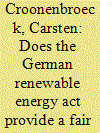

|
|
|
|
|
| Summary/Abstract |
We assess the German renewable energy incentive system for onshore wind power installations and provide a spatial profitability analysis for any given point in Germany. As it turns out, the system seems to favor certain types of facilities, dependent on the wind conditions at the site. We therefore narrow the focus down and analyze a limited set of locations selected at random. Here, we use a simulation analysis to assess the sensitivity of profitability on wind speeds, hub heights, and turbine types. Results show that increasing hub heights are not generally increasingly profitable — on the contrary, the German incentive system rather tends to favor lower hub heights. Also, the selected turbine type still has its impact on profitability — not at a great magnitude, but nevertheless gaugeable. In conclusion, the German renewable energy support system might be somewhat off target, as it possesses possibly unwanted side effects of which policy makers may not be aware.
|
|
|
|
|
|
|
|
|
|
|
|
|
|
|
|
| 4 |
ID:
125457


|
|
|
|
|
| Publication |
2013.
|
| Summary/Abstract |
This paper develops an indicator for the energy development potential (EDP) of 27 Brazilian states. This indicator uses data on a state's infrastructure and its supply of and demand for energy. The indicator measures the data for three periods: the first part of the 1990s, which is a period of low economic growth; the first part of the 2000s, which is a period of high economic growth but with a historical crisis in the Brazilian energy sector; and 2009-2011, which is a period of economic growth after the energy crisis. Using a factor analysis, we are able to identify three factors for EDP. They are the demand for energy, the supply of renewable energy, and the supply of nonrenewable energy. We use these factors to classify the Brazilian states according to their EDP and to perform an exploratory spatial data analysis (ESDA) by using the Moran indicators and the local indicators of spatial association (LISA).
|
|
|
|
|
|
|
|
|
|
|
|
|
|
|
|
| 5 |
ID:
096624
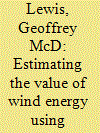

|
|
|
|
|
| Publication |
2010.
|
| Summary/Abstract |
There is an increasing interest in adding renewables such as wind to electricity generation portfolios in larger amounts as one response to concern about atmospheric carbon emissions from our energy system and the resulting climate change. Most policies with the aim of promoting renewables (e.g., RPS, FIT) do not explicitly address siting issues, which for wind energy are currently approached as the intersection of wind resource, land control, and transmission factors. This work proposes the use of locational marginal price (LMP), the location and time specific cost of electricity on the wholesale market, to signal locations where generation can address electricity system insufficiency. After an examination of the spatial and temporal behavior of LMP in Michigan over the first two years of wholesale market operation, this work combines LMP with wind speed data to generate a value metric. High value sites in Michigan tend to be sites with higher wind speeds, with the bulk of value accruing in the fall and winter seasons.
|
|
|
|
|
|
|
|
|
|
|
|
|
|
|
|
| 6 |
ID:
097464
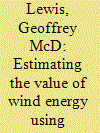

|
|
|
|
|
| Publication |
2010.
|
| Summary/Abstract |
There is an increasing interest in adding renewables such as wind to electricity generation portfolios in larger amounts as one response to concern about atmospheric carbon emissions from our energy system and the resulting climate change. Most policies with the aim of promoting renewables (e.g., RPS, FIT) do not explicitly address siting issues, which for wind energy are currently approached as the intersection of wind resource, land control, and transmission factors. This work proposes the use of locational marginal price (LMP), the location and time specific cost of electricity on the wholesale market, to signal locations where generation can address electricity system insufficiency. After an examination of the spatial and temporal behavior of LMP in Michigan over the first two years of wholesale market operation, this work combines LMP with wind speed data to generate a value metric. High value sites in Michigan tend to be sites with higher wind speeds, with the bulk of value accruing in the fall and winter seasons.
|
|
|
|
|
|
|
|
|
|
|
|
|
|
|
|
| 7 |
ID:
182660
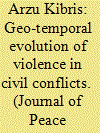

|
|
|
|
|
| Summary/Abstract |
Existing works on diffusion fail to account for the incapacitating effects conflict events may have on the operational capability of the combatant sides and how these effects may determine the evolution of a conflict. I hypothesize that it is those events with losses on the state side that are likely to be associated with geo-temporal spillovers, whereas events with insurgency losses are less likely to be associated with future mayhem in their vicinity. To test my arguments, I first introduce a new, comprehensive and detailed event dataset on the long-running civil conflict in Turkey. The Turkish State–PKK Conflict Event Database (TPCONED) includes the exact date and county-level location for the fatal events of the armed conflict between the Turkish state and the rebel organization PKK since its very beginning in 1984 with detailed information on combatant casualties. I then employ a split population bi-probit model which allows me to comprehensively depict the geotemporal evolution of the conflict by acknowledging, estimating and accounting for the variation in the underlying conflict proneness across locations as a latent variable that shapes the diffusion of events. The results of the statistical analyses offer support for my hypotheses and reveal that how events evolve over space and time is conditioned by the damages suffered by the combatant sides. I demonstrate the robustness of these results on a matched sample I obtain by employing the Coarsened Exact Matching (CEM) on the data.
|
|
|
|
|
|
|
|
|
|
|
|
|
|
|
|
| 8 |
ID:
167570


|
|
|
|
|
| Summary/Abstract |
This article seeks to deepen our understanding of the globalisation–growth nexus as it extends the investigation to using a spatial econometric approach, hitherto rarely used in the globalisation literature. The objective of the article is to uncover not only the significant growth effects of globalisation but also its possible spillover effects onto neighbouring countries. Using a panel data set of 83 countries across a 30-year period and via a spatial autoregressive panel data method, this article estimates a standard growth model augmented with a parameter to capture the countries’ spatial dependence, whilst controlling for globalisation indices. The findings indicate a positive effect of economic globalisation, which is dependent upon the political settings in the countries under study. The spillover effects of globalisation across neighbouring countries are shown, both in geographical and institutional spheres. The article concludes with some policy recommendations.
|
|
|
|
|
|
|
|
|
|
|
|
|
|
|
|
| 9 |
ID:
186442


|
|
|
|
|
| Summary/Abstract |
Feed-in tariff funding will cease by 2025 for more than 70% of the currently installed onshore wind turbines in Germany. For many wind turbines, the feasibility of repowering from a regulatory point of view is unknown; that is, a complete replacement of the old wind turbines with new, modern, and more efficient models. In Germany, restrictive regulations regarding the required minimum distances of wind turbines from residential and other protected areas may impede repowering, thereby rendering a site non-repowerable. Many of these wind turbine sites are well-established in terms of their acceptance by the local population. Our analysis shows that the potential of non-repowerable but well-established locations with more efficient technology at the same height is almost twice that of the sites qualified for repowering via higher wind turbines. The latest legislation of the German federal government prescribes minimum distances of 1,000 m between a wind turbine and the nearest residential buildings. This will slow down the expansion of onshore wind energy in Germany and decrease its contribution to climate neutrality. This study quantifies the nationwide effects of restrictive legislative minimum distance regulations on repowering potential by means of a developed geographic information system that utilizes highly detailed settlement structures.
|
|
|
|
|
|
|
|
|
|
|
|
|
|
|
|
| 10 |
ID:
173888
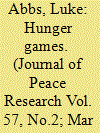

|
|
|
|
|
| Summary/Abstract |
Nonviolent movements are more successful when mobilizing large and diverse numbers of participants. However, while there has been considerable research on the outcomes of nonviolent campaigns, far less is known about the initial emergence of nonviolent action. A growing literature suggests ethnic divisions may undermine the ability of activists to engage in mass nonviolent mobilization across diverse social lines. Yet many large and diverse nonviolent movements have successfully emerged in various ethnically divided societies across the world. I argue that nonviolent mobilization is made possible in ethnically polarized contexts when broader cross-cutting grievances are present as they enable local activists to widen their appeal across social lines. I focus on food price spikes as an example of a cross-cutting issue that is likely to affect consumers from different ethnic groups. The unique and symbolic nature of food price spikes facilitates nonviolent mobilization across ethnic lines and provides clear short-term incentives for many people to participate in protests against the government. Using new spatially disaggregated data on government targeted nonviolent action, I analyse grid-cell years across 41 African countries (1990–2008). I find strong evidence that food price spikes increase the likelihood of nonviolent action in politically excluded and ethnically diverse locations.
|
|
|
|
|
|
|
|
|
|
|
|
|
|
|
|
| 11 |
ID:
176687
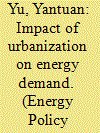

|
|
|
|
|
| Summary/Abstract |
This paper provides an empirical assessment of the effects of China's urbanization on its energy demand for 2003–2014 using a dataset of 108 cities located in the Yangtze River Economic Belt. Both demographic urbanization (DU) and land urbanization (LU) are considered in the empirical analysis. The results show that urbanization exerts significant and positive impacts on energy demand during the study period. Our empirical suggest that one unit rises in DU and LU rises the energy demand by 48.85% (91.62%) and 65.54% (68.09%), respectively, without (with) considering control variables. The energy demand effects of urbanization still hold when considering spatial and heterogeneity factors. These results are robust to alternative measures of urbanization and empirical model specifications. Our results indicate that policymakers should improve the quality of urbanization to promote the growth of high-tech and high-quality industries, avoiding excessive energy consumption with extensive urbanization. Large cities should not be allowed to grow unchecked. More attention should be paid to promote the development of medium-sized cities and implement a balanced population distribution among different cities. The energy demand structure (industrial and residential; primary and secondary; renewable and nonrenewable) should be optimized by introducing cleaner/low-carbon technology and its transformation.
|
|
|
|
|
|
|
|
|
|
|
|
|
|
|
|
| 12 |
ID:
154545


|
|
|
|
|
| Summary/Abstract |
Self-determination claims have abounded in the international system since the end of World War II. But these claims have not emerged everywhere. About half of the states in the international system face some challenge related to self-determination today. Why do some states face these demands while others do not? We argue that ethno-national self-determination is one of many identities with which individuals can find affinity. While an international norm related to self-determination has developed globally, its use as a basis for political claims has diffused regionally. Diffusion of self-determination occurs through observation of others using self-determination as a basis of organization, generating a sense of legitimacy, sensitivity to related grievance, and perceptions of tangible benefits related to self-determination identification. We test this empirically on global data on self-determination claims from 1960 to 2005 and find evidence of spatial diffusion, suggesting that self-determination is, to some extent, contagious.
|
|
|
|
|
|
|
|
|
|
|
|
|
|
|
|
| 13 |
ID:
107971


|
|
|
|
|
| Publication |
2011.
|
| Summary/Abstract |
Income varies considerably within countries and the locations where conflicts emerge are rarely typical or representative for states at large. Yet, most research on conflict has only examined national income averages and neglected spatial variation. The authors argue that civil conflicts are more likely to erupt in areas with low absolute income, even if a country's gross domestic product (GDP) per capita is not necessarily low, and in areas with large deviations from national averages. The authors test these hypotheses empirically using spatially disaggregated data on the location of conflict outbreaks and per capita income estimates. The authors find that areas with absolute poverty indeed see more outbreaks of conflict, and they find some evidence that inequality increases the risk of conflict. Subnational information can improve on conventional country-based measures and help our understanding of how local features and variation can give rise to mobilization and violence.
|
|
|
|
|
|
|
|
|
|
|
|
|
|
|
|
| 14 |
ID:
141193
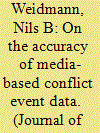

|
|
|
|
|
| Summary/Abstract |
Empirical researchers of civil war rarely collect data on violence themselves and instead rely on other sources of information. One frequently used source is media reports, which serve as the basis for many ongoing data projects in the discipline. However, news reports rarely cover a conflict comprehensively and objectively and may therefore be prone to various reporting issues. This article provides an analysis of the accuracy of information given in news reports. In particular, if focuses on two types of “hard facts” that event data sets require: the location of an event and its severity. By linking media reports to firsthand accounts from a military database, the article does two things: (1) it analyzes the determinants of inaccuracy and confirms the expectation that events with a low number of observers tend to have higher reporting inaccuracies and (2) it assesses the magnitude of these inaccuracies and the implications for conducting empirical analyses with media-based event data.
|
|
|
|
|
|
|
|
|
|
|
|
|
|
|
|
| 15 |
ID:
176653
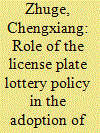

|
|
|
|
|
| Summary/Abstract |
Policy is an influential factor to the purchase and usage of Electric Vehicles (EVs). This paper is focused on the license plate lottery policy, a typical vehicle purchase restriction in Beijing, China. An agent-based spatial integrated urban model, SelfSim-EV, is employed to investigate how the policy may influence the uptake of EVs over time at the individual level. Two types of “what-if” scenario were set up to explore how the methods to allocate the vehicle purchase permits and the number of permits might influence the EV market expansion from 2016 to 2020. The results suggested that 1) both the allocation methods and the number of purchase permits could heavily influence the uptake of EVs and further its impacts on vehicular emissions, energy consumption and urban infrastructures; 2) compared to the baseline, both scenarios got significantly different spatial distributions of vehicle owners, transport facilities, vehicular emissions and charging demand at the multiple resolutions; 3) SelfSim-EV was found as a useful tool to quantify the nonlinear relationships between the increase of EV purchasers and the demand for transport facilities and electricity, and also to capture some unexpected results coming out from the interactions in the complex dynamic urban system.
|
|
|
|
|
|
|
|
|
|
|
|
|
|
|
|
| 16 |
ID:
093727


|
|
|
|
|
| Publication |
2010.
|
| Summary/Abstract |
Many nations today grapple with problems of social exclusion along ethno-religious lines and face demands for some kind of affirmative action by disadvantaged ethnic, racial and religious groups. In India, caste inequalities among Hindus have long been recognised and substantive measures for redressing disadvantages of lower castes have been in place for decades. Since India's Muslims, too, are faced with various types of social exclusion, there have been ongoing debates about the necessity of state intervention in the form of affirmative action for Muslims.
The article interrogates various strands of this debate. While relative socio-economic disadvantages among Muslims cannot be denied, how Muslims are currently presented as a marginalised and excluded community is shown to be too simplistic and actually leads to isolation. In view of the multi-dimensional nature of group disadvantage for Muslims, particularly spatial patterns observable across India, more careful understanding is needed to develop effective affirmative action policies. While deeply flawed reasoning grounds prevailing current arguments in favour of separate affirmative action for Muslims, the article suggests that the aim should be to achieve better development for all disadvantaged people from all communities in any particular space.
|
|
|
|
|
|
|
|
|
|
|
|
|
|
|
|
| 17 |
ID:
181330


|
|
|
|
|
| Summary/Abstract |
Narratives of the Indian revolutionary movement in exile have often focused on abstract notions of ‘London’—with a particular focus on ‘India House’ in Highgate—or ‘Paris’ without taking into account specific geographies of Indian anti-colonialism within these imperial metropoles. Drawing on addresses provided in intelligence reports, this article takes a spatial approach and explores how particular areas of London and Paris enabled the development of the Indian revolutionary movement in exile in the early twentieth century.
|
|
|
|
|
|
|
|
|
|
|
|
|
|
|
|
| 18 |
ID:
152455
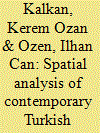

|
|
|
|
|
| Summary/Abstract |
This study offers a comprehensive approach to spatial analysis of parliamentary elections in Turkey since 2002. Using advanced spatial models, we find that electoral competitiveness and concentration mostly stabilized in the Western subprovinces whereas they are still in flux in the Eastern and Southern regions. There is an increasing level of geographically dependent concentration and competitiveness in recent elections, particularly in the 2015 elections (June and November). Our analyses also show that while the ruling AKP party has become the party of all regions, its competitors (CHP, MHP, and HDP) exhibit a narrowing geographical appeal.
|
|
|
|
|
|
|
|
|
|
|
|
|
|
|
|
| 19 |
ID:
154369
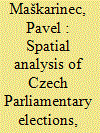

|
|
|
|
|
| Summary/Abstract |
This article presents a spatial analysis of the parliamentary elections in the Czech Republic between 2006 and 2013. Among most political parties with long-term parliamentary representation, right-wing parties had higher support in areas with a high development potential and left-wing parties in areas with a low development potential. However, similar congruence between electoral support and development potential was not found in the case of most new parties. Spatial regression analyses then show that class conflict has ceased to be the unambiguous primary factor of political competition in the Czech Republic. This finding is further supported by the often inconclusive estimates for most new parties, which showed their ability to mobilise voters from different social classes.
|
|
|
|
|
|
|
|
|
|
|
|
|
|
|
|
| 20 |
ID:
169884
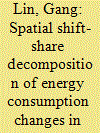

|
|
|
|
|
| Summary/Abstract |
The objective of this paper is to investigate the changes in the regional energy consumption at the provincial level in China from 2007 to 2016 by introducing a spatial shift-share decomposition approach to measure the neighborhood effect on the regional energy efficiency change through the establishment of a spatial weight matrix considering the geographical and economic proximity. Using this decomposition method, the regional advantage (or disadvantage) in energy efficiency can be revealed, excluding the influence of neighborhood performance in terms of energy efficiency. The results indicate that a shift from energy intensive industrial productions toward the less energy intensive service sector occurs in almost all provinces of China over the period observed; there is significant spatial differentiation on the spatial decomposition of the efficiency change component across provinces, and the changes in energy efficiency in provinces of Jing-Jin-Ji, Yangtze River Delta, Chengdu-Chongqing, Guanzhong Plain, Pan-Pearl River Delta city agglomeration and the three provinces in Northeast China are mainly affected by the neighborhood effect. Our empirical findings suggest that energy policy making should be more concerned about the spatial correlation and coupling effects of energy consumption, especially in the national urban agglomeration of China.
|
|
|
|
|
|
|
|
|
|
|
|
|
|
|
|
|
|
|
|
|